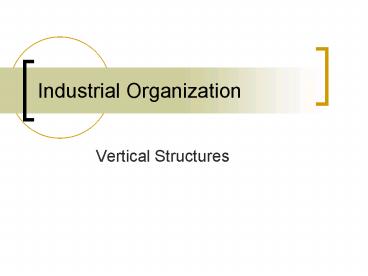Industrial Organization - PowerPoint PPT Presentation
1 / 25
Title:
Industrial Organization
Description:
Two-stage game: Plug pw back into retailer's solution: We want to compare VI and VS: ... downstream firm is granted a monopoly within a predetermined geographic region ... – PowerPoint PPT presentation
Number of Views:49
Avg rating:3.0/5.0
Title: Industrial Organization
1
Industrial Organization
- Vertical Structures
2
Vertical Structure
- So far firms sell directly to consumers
- In many cases
c
Upstream (e.g. manufacturer, farmer)
Pw
Downstream (e.g. processor, retailer)
PR
Demand qf(PR)
3
Vertical Structure
- Why vertical separation?
- Efficiency
- Upstream unit can specialize in manufacturing
- Downstream unit can specialize in retailing
- Legal
- Vertical integration is often seen as
anticompetitive. Separation is mandated by law
4
Vertical Structure
- Why not Vertical Separation?
- Manufacturer does not control all variables
directly (e.g. promotion, quality, service,
price) - Inefficiencies
- If both upstream and downstream firms have some
market power, solution is inefficient (double
marginalization) - Contract costs, monitoring, negotiation
- Opportunistic behavior (e.g. free riding by
retailers)
5
Vertical Structure
- Why not Vertical Separation?
- Retailers objectives not aligned with
manufacturers - Other
- Assure supply (hold up problem)
- Example sugar production in Slovakia
- Price discriminate (e.g. aluminum)
6
Vertical Structure
- Suppose q1-Pr
- With Vertical Integration (VI)
7
Vertical Structure
- Vertical integration
PVI
Dr (Demand)
C
MRr
Q
QVI
8
Double Marginalization
- Vertical separation inefficient if market power
at both levels - Case 1 Retailer has no market power. PrPw.
Wholesalers profit maximization problem becomes
the VI problem - Case 2 Wholesaler has no market power. Pwc.
Retailers profit maximization problem becomes
the VI problem. - Case 3 Neither has market power. Then
competitive solution Prc regardless of VI or
vertical separation (VS)
9
Double Marginalization
- Set up
- Wholesaler (upstream)
- Retailer (downstream)
Wholesale price
Retail price
Retailers only cost
10
Double Marginalization
Two-stage game
Retailer (2nd stage)
Wholesaler (1st stage)
11
Double Marginalization
- Plug pw back into retailers solution
- We want to compare VI and VS
12
Double Marginalization
A
B
Pr
C
D
PwCr
PwPVI
Dr (Demand)
E
F
G
Cw
Dr
MRrDw
MRw
Q
QVS
QVI
13
Solutions to Double Marginalization
- Franchise fees
- Upstream firm sets pwc
- Downstream sets prpiv
- Upstream firm charges franchise fee
- Resale Price Maintenance (RPM)
- Upstream firm forces downstream firm to charge
the VI price - Quantity is set at the VI level
14
Franchise Fee
A
B
PVI
Demand
E
G
PwCwCr
MRwMRr
Q
QVI
- Franchise fee PVIBEG
15
Franchise Fee
- Retail price and quantity correspond to VI
solution - Downstream unit generates zero profit
- Total welfare increases
- Examples
- McDonalds, Starbucks
16
Resale Price Maintenance
?r
?w
RPMPVI
Pw
c
Demand
MR
Q
QIV
- Downstream firm sells at PVI
- Upstream firm sets Pw between c and PVI
- Profits are split based on Pw location
17
Agency and Efficiency Problems
Manufacturer (Upstream)
Pw
D1
D2
Demand qf(PR)
- Sharing the market may mean less investment (or
none at all) - Free riding
- Service, promotion, quality, are public goods
18
Agency and Efficiency Problems
- More free riding
- Downstream firm can use upstreams investment in
other activities (e.g. selling more profitable
brands) - Upstream firm under-invests because of
anticipated oportunistic behavior
19
Agency and Efficiency Problems Solutions
- Usually called Vertical Restrictions
- Exclusive Distribution downstream firm can only
sell upstreams products (none from the
competition) - Exclusive Territories downstream firm is
granted a monopoly within a predetermined
geographic region (not allowed to sell anywhere
else) - For retailers guaranteed radius
- Resale price maintenance (RPM) all downstream
firms are supposed to sell at same (minimum)
price
20
Exclusive Distribution
- Key Downstream unit must make sure demand is big
enough - Solves incentive problem
- Upstream firms investments are protected
equipment, training, etc - Objectives are aligned downstream firm focuses
effort on upstream firms products only - Upstream firm increases investments
- This decreases distribution costs (better
equipment, training, etc.) - Enhanced consumer demand
21
Exclusive Territories
- Aligned incentives
- Quality of service is no longer a public good
- Demand level is guaranteed this provides larger
investment incentives for distributor - May enhance consumer surplus
- Better service quality stimulates demand
- Wider selection of products
- With no exclusive territories there can be
under-provision of products
22
Example US Brewing Industry
D
D2
23
RPM
- Maximum RPM
- Avoid DM problem
- Concern retailers may think this is unfair
(insufficient margins) - Minimum RPM
- Avoid free riding problem
- Concern consumers facing higher prices
24
Anticompetitive Behavior?
- Antitrust authorities may not like these
contracts (VR) - Exclusive territories may increase downstream
firms market power by reducing intrabrand
competition - Exclusive distribution
- May exclude smaller downstream firms
- Force use of less efficient channels
- RPM related to price fixing in horizontal case
upstream firm more market power?
25
Anticompetitive Behavior?
- However positive effects too
- More efficient downstream firms in the presence
of exclusive dealing (lower costs from higher
upstream investment) - More investment in the presence of exclusive
territories - RPM eliminates double marginalization
- Enhanced provision of services (increased
consumer welfare) with both ET and ED































